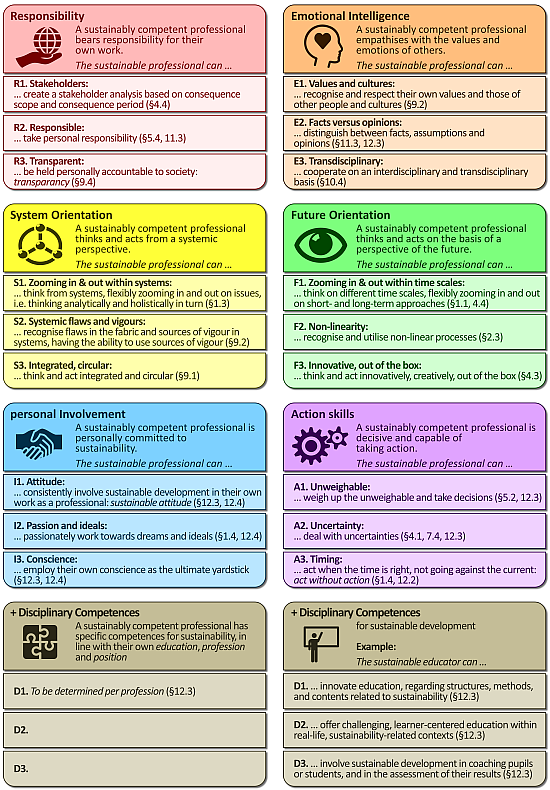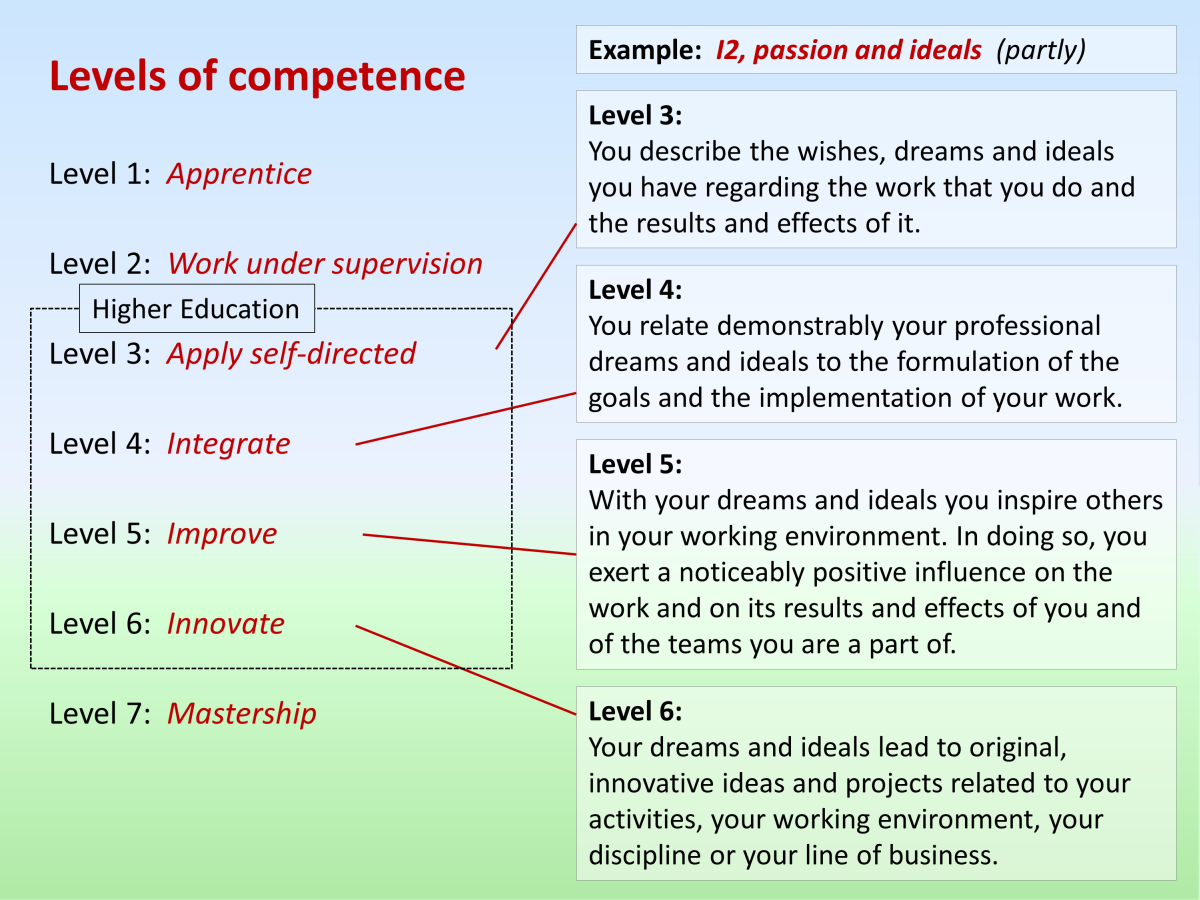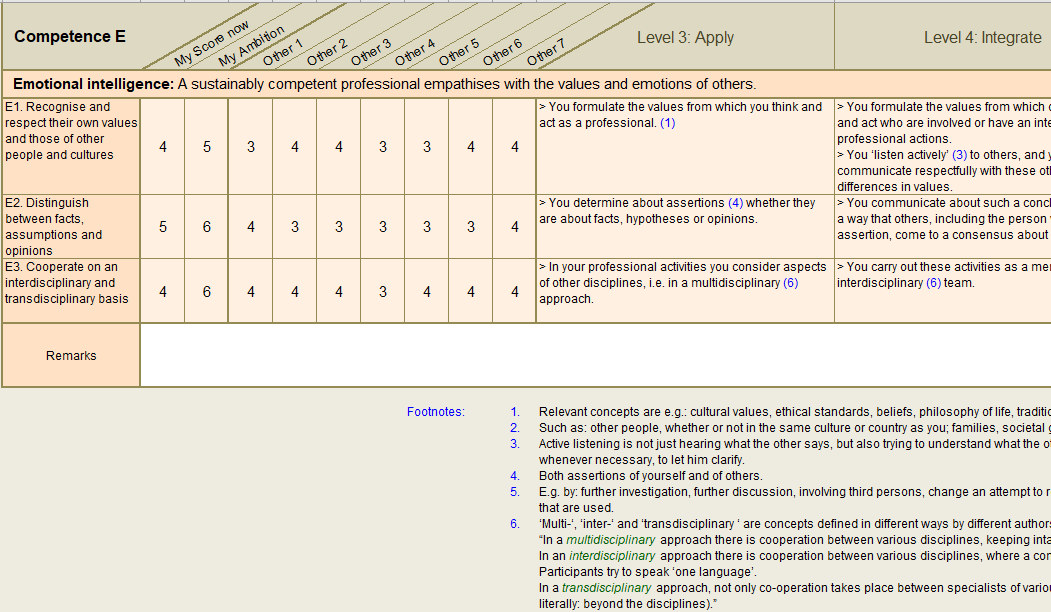RESFIA+D: The introduction |
RESFIA+D is a management method for the assessment of competences for sustainable development of individuals, curricula in education, and teams & departments of companies. The method is described in Chapter 12 and the Appendix of:
- In English: the textbook Fundamentals of Sustainable Development, edition 2025.
- In Dutch: the textbook Basisboek Duurzame Ontwikkeling, editie 2025.
- In German: the textbook Grundlagen der nachhaltigen Entwicklung, Ausgabe 2025.
> For an instruction manual for RESFIA+D, go to the RESFIA+D pages of these books in English, German or Dutch.
Download RESFIA+D
> The scoring spreadsheets, together with the explanations on these webpages, are all you need to apply RESFIA+D.
> Freely download the scoring spreadsheets: For Individual Professionals and Students: in English, German or Dutch;
For Universities, Colleges and Schools: in English, German or Dutch;
For Companies, Teams and Organisations: in English, German or Dutch.
> Download a filled-in example spreadsheet (for Individual Professionals and Students): in English, German or Dutch.
> If you need more information, or any kind of assistance, feel free to contact RESFIA+D's developer, Dr. Niko Roorda.
> See on the next pages: - The Sustainably Competent Professional, an explanation of the basic concept - Theoretical backgrounds of RESFIA+D - The Seven Competences, a summary in English, German and Dutch - Levels of Competence, ranging from the Apprentice to the Master - The Seven Competences, a one-by-one description in English: see on the right ----> - Spectral Completeness of RESFIA+D - Disciplinary Competences, an example: The Sustainably Competent Educator
> For detailed information (see the Bibliography ): - Books: Roorda (2010); Roorda (2015); Roorda & Rachelson (2018) - Journal articles & Chapters: Roorda (2016); Roorda & Rachelson (2019) |
 The 7 Competences of the Sustainable Professional
The 7 Competences of the Sustainable Professional
When Competence Based Education was widely introduced in Higher Education, in the first decade of the 21st century, Roorda frequently received questions about competences for sustainable development (SD).
The main question was:
"What do you think: should SD be one or more separate competences, to be added to the existing competence profile? Or does our current competence profile already cover everything?"
The answer, according to Roorda, was somewhere in the middle. Yes, there are competences that are vital for professionals (and hence for students) if they want to contribute to SD.
But these competences should not be added to existing sets of competences as an "extra": they should be integrated in them, as SD should be an integrated element of the skills and the behavior of all professionals.
As a part of his PhD research, Roorda decided to develop a tool for the integration of SD into competence profiles of BSc, MSc and PhD programs. The result, as discussed in Roorda's dissertation (2010), is called RESFIA+D: an acronym, where the seven characters stand for the seven competences the system consists of. Figure 12.04: The 7 competences of RESFIA+D and their 21 achievements
The system of RESFIA+D consists of six general competences, that apply - or should apply - to each and every professional, regardless of the discipline, line of business, the level at which the professional works, or whether a paid job is involved, or a (perhaps unpaid) voluntary task.
Each of the six general competences ("RESFIA") is divided into three more concrete achievements, as the above image shows. So, there are 18 detailed general competence descriptions in total.
RESFIA+D makes use of 7 levels of competence. Four of them, levels 3 till 6, are suitable targets for higher education. For that reason, these levels have been made explicit for all of the 18 generic competences, as the following image illustrates for one of the 18.

Plus: a whole range of disciplinary competences
In addition to the six general competences, the 7th competence is "Disciplinary" ("+D"). This is not general but specific, i.e. differing for every kind of discipline. Hence, it is actually a very large, potentially unlimited group of competences, as each discipline and every industry or profession has its own demands and characteristics.
A more detailed description of the disciplinary competences is on this page.
Three types of application
RESFIA+D is applicable in three ways. For each of them, the following links lead to the explanation, the instruction manual, and the download links for the scoring spreadsheets in English, Dutch and German.
- RESFIA+D for Individual Professionals and Students, creating a Personal Development Plan (PDP); > see the image below
- RESFIA+D for Universities, Colleges and Schools, to create or improve curricula of study programs;
- RESFIA+D for Companies, Teams and Organisations, to create or improve a strategy for Human Resource Development (HRD).

Screenshot of the Scoring Spreadsheet for Individuals

